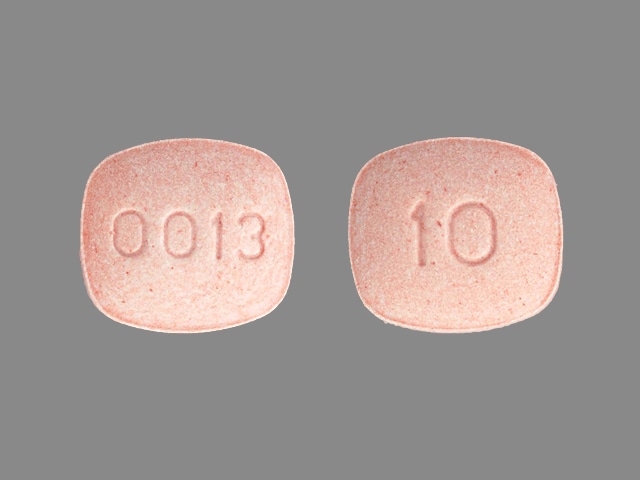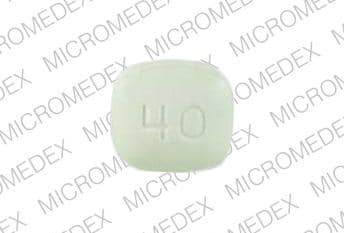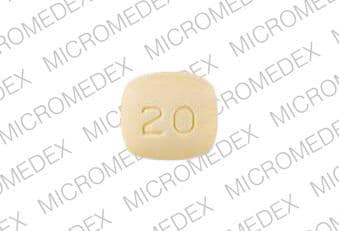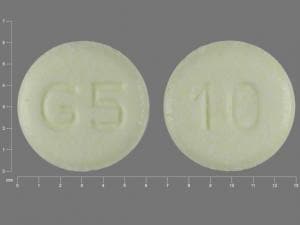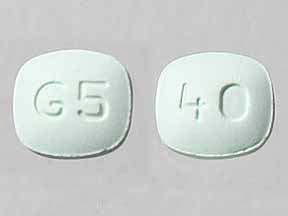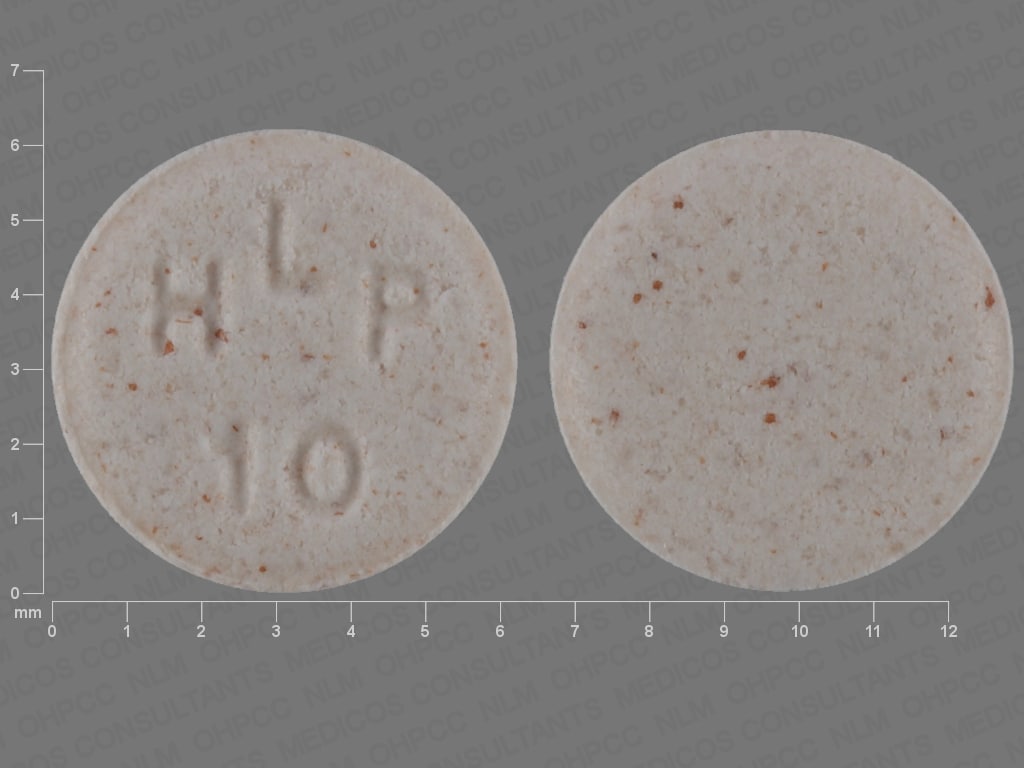Dosage Forms
Excipient information presented when available (limited, particularly for generics); consult specific product labeling. [DSC] = Discontinued product
Tablet, Oral, as sodium:
Pravachol: 20 mg
Pravachol: 40 mg [contains fd&c blue #1 aluminum lake, fd&c yellow #10 aluminum lake]
Pravachol: 80 mg [DSC]
Generic: 10 mg, 20 mg, 40 mg, 80 mg
Pharmacology
Mechanism of Action
Pravastatin is a competitive inhibitor of 3-hydroxy-3-methylglutaryl coenzyme A (HMG-CoA) reductase, which is the rate-limiting enzyme involved in de novo cholesterol synthesis. In addition to the ability of HMG-CoA reductase inhibitors to decrease levels of high-sensitivity C-reactive protein (hsCRP), they also possess pleiotropic properties including improved endothelial function, reduced inflammation at the site of the coronary plaque, inhibition of platelet aggregation, and anticoagulant effects (de Denus 2002; Ray 2005).
Pharmacokinetics/Pharmacodynamics
Absorption
Rapidly absorbed; average absorption 34%
Distribution
Vd: 0.46 L/kg
Metabolism
Hepatic multiple metabolites; primary metabolite is 3 alpha-hydroxy-iso-pravastatin (2.5% to 10% activity of parent drug); extensive first-pass metabolism
Excretion
Feces (70%); urine (~20%, 8% as unchanged drug)
Onset of Action
Several days; Peak effect: 4 weeks; LDL-reduction: 40 mg/day: 34% (for each doubling of this dose, LDL-C is lowered by ~6%)
Time to Peak
Serum: 1-1.5 hours
Half-Life Elimination
Children and Adolescents (4.9-15.6 years): 1.6 hours; range: 0.85 to 4.2 hours (Hedman 2003)
Adults: 77 hours (including all metabolites); Pravastatin: ~2 to 3 hours (Pan 1990); 3 alpha hydroxy-iso-pravastatin: ~1.5 hours (Gustavson 2005)
Protein Binding
~50%
Use in Specific Populations
Special Populations: Elderly
Mean AUC was approximately 27% greater and mean cumulative urinary excretion was approximately 19% lower in elderly men. Mean AUC was approximately 46%higher and mean cumulative urinary excretion was approximately 18% lower in elderly women.
Use: Labeled Indications
Hyperlipidemia
Dysbetalipoproteinemia: Treatment of primary dysbetalipoproteinemia (Fredrickson type III) in patients who do not respond adequately to diet.
Heterozygous familial hypercholesterolemia: Adjunct to diet in children ≥8 years and adolescents with heterozygous familial hypercholesterolemia (HeFH) if after an adequate trial of diet therapy the following findings are present: LDL-C ≥190 mg/dL or LDL ≥160 mg/dL with positive family history of premature cardiovascular disease (CVD), or with 2 or more other CVD risk factors.
Hypercholesterolemia and mixed dyslipidemia: Adjunct to diet to reduce elevated total cholesterol, LDL-C, apo B, and triglyceride (TG) levels and to increase HDL-C in patients with primary hypercholesterolemia and mixed dyslipidemia (Fredrickson Types IIa and IIb).
Limitations of use: Has not been studied in conditions where the major lipid abnormality is elevation of chylomicrons (Fredrickson types I and V).
Prevention of cardiovascular disease
Primary prevention of cardiovascular disease: To reduce the risk of myocardial infarction, revascularization procedures and cardiovascular mortality in hypercholesterolemic patients without established coronary heart disease (CHD).
Secondary prevention of cardiovascular disease: To slow the progression of coronary atherosclerosis; to reduce the risk of myocardial infarction, revascularization procedures, and total mortality; and to reduce the risk of stroke and transient ischemic attacks (TIA) in patients with established CHD.
Use: Off Label
Cardiac risk reduction for noncardiac surgery (perioperative therapy)yes
Based on the 2014 American College of Cardiology/American Heart Association (ACC/AHA) guidelines on perioperative cardiovascular evaluation and management of patients undergoing noncardiac surgery, perioperative initiation of statins is reasonable for patients undergoing vascular surgery and may be considered in patients with clinical indications according to guideline-directed medical therapy who are undergoing elevated risk procedures. In patients undergoing non-cardiac surgery who are currently receiving a statin, the statin should be continued.
Noncardioembolic stroke/Transient ischemic attack (secondary prevention)yes
Based on the American Heart Association/American Stroke Association (AHA/ASA) guidelines for the prevention of stroke in patients with stroke and transient ischemic attack, statin therapy with intensive lipid-lowering effects is recommended to reduce the risk of recurrent stroke and future cardiovascular events in patients with ischemic stroke or TIA presumed to be of atherosclerotic origin who have an LDL-C concentration ≥100 mg/dL (with or without evidence for other clinical atherosclerotic cardiovascular disease [ASCVD]) or who have an LDL-C concentration <100 mg/dL (without evidence for other clinical ASCVD).
Contraindications
Hypersensitivity to pravastatin or any component of the formulation; active liver disease; unexplained persistent elevations of serum transaminases; pregnancy; breast-feeding
Dosage and Administration
Dosing: Adult
Note: Doses should be individualized according to the baseline LDL-cholesterol levels, the recommended goal of therapy, and patient response; adjustments should be made at intervals of 4 weeks or more; doses may need adjusted based on concomitant medications.
Hyperlipidemias, primary prevention of coronary events, secondary prevention of cardiovascular events (also see ACC/AHA Blood Cholesterol Guideline recommendations): Oral: Initial: 40 mg once daily; titrate dosage to response (maximum dose: 80 mg/day)
Prevention of cardiovascular disease/reduce the risk of atherosclerotic cardiovascular disease: Oral:
ACC/AHA Blood Cholesterol Guideline recommendations (ACC/AHA [Grundy 2018]; ACC/AHA [Stone 2013]):
Note: When choosing to initiate therapy and selecting dose-intensity, consider atherosclerotic cardiovascular disease (ASCVD) risk, risk-enhancing factors, possibility for side effects, and drug interactions.
Primary prevention:
LDL-C ≥190 mg/dL and age 20 to 75 years: High-intensity therapy necessary; use alternate statin therapy (eg, atorvastatin or rosuvastatin)
Diabetes, age 40 to 75 years, and an estimated 10-year ASCVD risk <7.5%: Moderate-intensity therapy: 40 to 80 mg once daily
Diabetes, age 40 to 75 years, and an estimated 10-year ASCVD risk ≥7.5%: High-intensity therapy necessary; use alternate statin therapy (eg, atorvastatin or rosuvastatin)
LDL-C 70 to 189 mg/dL, age 40 to 75 years, and an estimated 10-year ASCVD risk ≥7.5%: Moderate- to high-intensity therapy: 40 to 80 mg once daily or consider using high-intensity statin therapy (eg, atorvastatin or rosuvastatin)
Secondary prevention:
Patient has clinical ASCVD (eg, coronary heart disease, stroke/TIA, or peripheral arterial disease presumed to be of atherosclerotic origin) or is post-CABG (AHA [Kulik 2015]) and:
Age ≤75 years: High-intensity therapy necessary; use alternate statin therapy (eg, atorvastatin or rosuvastatin)
Age >75 years: Moderate- to high-intensity therapy: 40 to 80 mg once daily or consider using high-intensity statin therapy (eg, atorvastatin or rosuvastatin); if moderate-intensity therapy is started and tolerated, increase to a high-intensity statin therapy within 3 months (Rosenson 2019).
US Preventive Services Task Force recommendations (USPSTF 2016): Age 40 to 75 years, no history of CVD, with ≥1 CVD risk factor (dyslipidemia, diabetes, hypertension, or smoking), and calculated 10-year CVD event risk of ≥10%:
Primary prevention:
Low-intensity therapy: 10 to 20 mg once daily
Moderate-intensity therapy: 40 to 80 mg once daily
Note: These recommendations do not pertain to patients with very high cholesterol levels (eg, LDL >190 mg/dL, familial hypercholesterolemia; were excluded from primary prevention trials); use clinical judgment in the treatment of these patients. In patients with a calculated 10-year CVD event risk of 7.5% to 10%, statin use may be considered based on patient characteristics.
Dosage adjustment for pravastatin with concomitant medications:
Clarithromycin: Maximum pravastatin dose: 40 mg/day.
Cyclosporine: Initial pravastatin dose: 10 mg once daily, titrate with caution (maximum dose: 20 mg/day)
Dosing: Geriatric
Refer to adult dosing.
Dosing: Pediatric
Note: Dosage should be individualized according to the baseline LDL-C level, the recommended goal of therapy, and patient response; adjustments should be made at intervals of 4 weeks.
Hyperlipidemia or heterozygous familial and nonfamilial hypercholesterolemia:
Note: Begin treatment if, after adequate trial (6 to 12 months) of intensive lifestyle modification emphasizing body weight normalization and diet, the following are present (AACE [Jellinger 2017]):
LDL-C ≥190 mg/dL or
LDL-C remains ≥160 mg/dL and two or more cardiovascular risk factors: Family history of premature atherosclerotic cardiovascular disease (<55 years of age), overweight, obesity, or other elements of insulin resistance syndrome or
LDL-C ≥130 mg/dL and diabetes mellitus (Daniels 2008; NHLBI 2011)
Therapy may also be considered for children 8 to 9 years of age meeting the above criteria or for children with diabetes mellitus and LDL-C ≥130 mg/dL (Daniels 2008).
Children and Adolescents 8 to 13 years: Oral: 20 mg once daily; lower doses (5 and 10 mg/day) have been evaluated and less efficacy observed compared to 20 mg doses (NHLBI 2011; Vuorio 2017); doses >20 mg have not been studied (Vuorio 2017)
Adolescents 14 to 18 years: Oral: 40 mg once daily; lower doses have been evaluated and less efficacy observed; doses >40 mg have not been studied (NHLBI 2011; Vuorio 2017)
Dosing adjustment for pravastatin with concomitant medications: Clarithromycin, cyclosporine: Children ≥8 years and Adolescents: There are no recommendations in the manufacturer's labeling for patients ≤18 years; based on experience in adult patients, dosage reduction suggested with concomitant clarithromycin or cyclosporine.
Dosing adjustment for toxicity: Muscle symptoms (potential myopathy): Children ≥8 years and Adolescents: Discontinue use until symptoms can be evaluated; check CPK level; based on experience in adult patients, also evaluate patient for conditions that may increase the risk for muscle symptoms (eg, hypothyroidism, reduced renal or hepatic function, rheumatologic disorders such as polymyalgia rheumatica, steroid myopathy, vitamin D deficiency, or primary muscle diseases). Upon resolution (symptoms and any associated CPK abnormalities), resume the original or consider a lower dose of pravastatin and retitrate. If muscle symptoms recur, discontinue pravastatin use. After muscle symptom resolution, may then reinitiate a different statin at an initial low dose; gradually increase if tolerated. Based on experience in adult patients, if muscle symptoms or elevated CPK persists for 2 months in the absence of continued statin use, consider other causes of muscle symptoms. If determined to be due to another condition aside from statin use, may resume statin therapy at the original dose (NHLBI 2011; Stone 2013).
Dosing: Adjustment for Toxicity
Severe muscle symptoms or fatigue: Promptly discontinue use; evaluate CPK, creatinine, and urinalysis for myoglobinuria (ACC/AHA [Stone 2013]).
Mild to moderate muscle symptoms: Discontinue use until symptoms can be evaluated; evaluate patient for conditions that may increase the risk for muscle symptoms (eg, hypothyroidism, reduced renal or hepatic function, rheumatologic disorders such as polymyalgia rheumatica, steroid myopathy, vitamin D deficiency, primary muscle diseases). Upon resolution, resume the original or lower dose of pravastatin. If muscle symptoms recur, discontinue pravastatin use. After muscle symptom resolution, may then use a low dose of a different statin; gradually increase if tolerated. In the absence of continued statin use, if muscle symptoms or elevated CPK continues after 2 months, consider other causes of muscle symptoms. If determined to be due to another condition aside from statin use, may resume statin therapy at the original dose (ACC/AHA [Stone 2013]).
Administration
Administer without regard to meals.
Dietary Considerations
Before initiation of therapy, patients should be placed on a standard cholesterol-lowering diet for 6 weeks and the diet should be continued during drug therapy.
Red yeast rice contains variable amounts of several compounds that are structurally similar to HMG-CoA reductase inhibitors, primarily monacolin K (or mevinolin) which is structurally identical to lovastatin; concurrent use of red yeast rice with HMG-CoA reductase inhibitors may increase the incidence of adverse and toxic effects (Lapi 2008; Smith 2003).
Storage
Store at 25°C (77°F); excursions permitted to 15°C to 30°C (59°F to 86°F). Protect from light.
Pravastatin Images
Drug Interactions
Acipimox: May enhance the myopathic (rhabdomyolysis) effect of HMG-CoA Reductase Inhibitors (Statins). Monitor therapy
Antihepaciviral Combination Products: May increase the serum concentration of Pravastatin. Management: Limit the pravastatin dose to a maximum of 40 mg per day when used with antihepaciviral combination products and monitor patients for evidence of pravastatin toxicities (eg, myopathy). Consider therapy modification
Asunaprevir: May increase the serum concentration of HMG-CoA Reductase Inhibitors (Statins). Monitor therapy
Bezafibrate: May enhance the myopathic (rhabdomyolysis) effect of HMG-CoA Reductase Inhibitors (Statins). Bezafibrate may increase the serum concentration of HMG-CoA Reductase Inhibitors (Statins). More specifically, bezafibrate may increase the serum concentration of fluvastatin Management: Monitor patients closely for myopathy with concomitant use of bezafibrate and HMG-CoA reductase inhibitors. Concomitant use is contraindicated in patients predisposed to myopathy and alternative therapy should be considered. Consider therapy modification
Bile Acid Sequestrants: May decrease the serum concentration of Pravastatin. Management: Administer pravastatin at least 1 hour before or 4 hours after administration of bile-acid resins (eg, cholestyramine, colestipol, colesevelam) to minimize the risk for any significant interaction. Consider therapy modification
CarBAMazepine: May decrease the serum concentration of Pravastatin. Monitor therapy
Ciprofibrate: May enhance the adverse/toxic effect of HMG-CoA Reductase Inhibitors (Statins). Management: Avoid the use of HMG-CoA reductase inhibitors and ciprofibrate if possible. If concomitant therapy is considered, benefits should be carefully weighed against the risks, and patients should be monitored closely for signs/symptoms of muscle toxicity. Consider therapy modification
Clarithromycin: May increase the serum concentration of Pravastatin. Management: Limit pravastatin to a maximum of 40 mg/day (for adults) when used in combination with clarithromycin. If this combination is used, monitor patients more closely for evidence of pravastatin toxicity. Consider therapy modification
Colchicine: May enhance the myopathic (rhabdomyolysis) effect of HMG-CoA Reductase Inhibitors (Statins). Colchicine may increase the serum concentration of HMG-CoA Reductase Inhibitors (Statins). Consider therapy modification
CycloSPORINE (Systemic): May increase the serum concentration of Pravastatin. Pravastatin may increase the serum concentration of CycloSPORINE (Systemic). Management: Limit pravastatin to 20 mg/day in patients who are also receiving cyclosporine. Consider therapy modification
Daclatasvir: May increase the serum concentration of HMG-CoA Reductase Inhibitors (Statins). Monitor therapy
DAPTOmycin: HMG-CoA Reductase Inhibitors (Statins) may enhance the adverse/toxic effect of DAPTOmycin. Specifically, the risk of skeletal muscle toxicity may be increased. Management: Consider temporarily stopping HMG-CoA reductase inhibitor therapy prior to daptomycin. If used together, regular (i.e., at least weekly) monitoring of CPK concentrations is recommended. Consider therapy modification
Darunavir: May increase the serum concentration of Pravastatin. This effect has been demonstrated with darunavir/ritonavir and may occur with darunavir/cobicistat. The individual contributions of darunavir, ritonavir, and cobicistat are unknown. Monitor therapy
Efavirenz: May decrease the serum concentration of Pravastatin. Monitor therapy
Eltrombopag: May increase the serum concentration of OATP1B1/1B3 (SLCO1B1/1B3) Substrates. Monitor therapy
Erythromycin (Systemic): May increase the serum concentration of Pravastatin. Monitor therapy
Fenofibrate and Derivatives: May enhance the adverse/toxic effect of HMG-CoA Reductase Inhibitors (Statins). Monitor therapy
Fosphenytoin: May decrease the serum concentration of HMG-CoA Reductase Inhibitors (Statins). Consider therapy modification
Fusidic Acid (Systemic): May enhance the adverse/toxic effect of HMG-CoA Reductase Inhibitors (Statins). Specifically, the risk for muscle toxicities, including rhabdomyolysis may be significantly increased. Management: Avoid concurrent use whenever possible. Use is listed as contraindicated in product characteristic summaries in several countries, although UK labeling suggests that use could be considered under exceptional circumstances and with close supervision. Avoid combination
Gemfibrozil: May enhance the myopathic (rhabdomyolysis) effect of Pravastatin. Gemfibrozil may increase the serum concentration of Pravastatin. Avoid combination
Glecaprevir and Pibrentasvir: May increase the serum concentration of HMG-CoA Reductase Inhibitors (Statins). Management: Use the lowest statin dose possible if combined with glecaprevir/pibrentasvir and monitor for increased statin effects/toxicities. Avoid concomitant use with atorva-, simva-, or lovastatin. Limit rosuvastatin to 10 mg daily and reduce pravastatin dose 50% Consider therapy modification
Itraconazole: May increase the serum concentration of Pravastatin. Monitor therapy
Lanthanum: HMG-CoA Reductase Inhibitors (Statins) may decrease the serum concentration of Lanthanum. Management: Administer HMG-CoA reductase inhibitors at least two hours before or after lanthanum. Consider therapy modification
Letermovir: May increase the serum concentration of HMG-CoA Reductase Inhibitors (Statins). Monitor therapy
Nelfinavir: May decrease the serum concentration of Pravastatin. Monitor therapy
Niacin: May enhance the adverse/toxic effect of HMG-CoA Reductase Inhibitors (Statins). Monitor therapy
Niacinamide: May enhance the adverse/toxic effect of HMG-CoA Reductase Inhibitors (Statins). Monitor therapy
PARoxetine: Pravastatin may enhance the adverse/toxic effect of PARoxetine. Specifically, blood glucose elevations may occur with the combination. Monitor therapy
Phenytoin: May decrease the serum concentration of HMG-CoA Reductase Inhibitors (Statins). Consider therapy modification
Raltegravir: May enhance the myopathic (rhabdomyolysis) effect of HMG-CoA Reductase Inhibitors (Statins). Monitor therapy
Red Yeast Rice: May enhance the adverse/toxic effect of HMG-CoA Reductase Inhibitors (Statins). Avoid combination
Repaglinide: HMG-CoA Reductase Inhibitors (Statins) may increase the serum concentration of Repaglinide. Monitor therapy
RifAMPin: May decrease the serum concentration of Pravastatin. Monitor therapy
Rifamycin Derivatives: May decrease the serum concentration of HMG-CoA Reductase Inhibitors (Statins). Management: Consider use of noninteracting antilipemic agents (note: pitavastatin concentrations may increase with rifamycin treatment). Monitor for altered HMG-CoA reductase inhibitor effects. Rifabutin and fluvastatin, or possibly pravastatin, may pose lower risk. Consider therapy modification
Rupatadine: May enhance the adverse/toxic effect of HMG-CoA Reductase Inhibitors (Statins). Specifically, the risk for increased CPK and/or other muscle toxicities may be increased. Monitor therapy
Saquinavir: May decrease the serum concentration of Pravastatin. This effect has only been demonstrated with saquinavir/ritonavir. The individual contributions of saquinavir and ritonavir are unknown. Monitor therapy
Simeprevir: May increase the serum concentration of Pravastatin. Monitor therapy
Telithromycin: May increase the serum concentration of Pravastatin. Monitor therapy
Teriflunomide: May increase the serum concentration of OATP1B1/1B3 (SLCO1B1/1B3) Substrates. Monitor therapy
Tolvaptan: May increase the serum concentration of OATP1B1/1B3 (SLCO1B1/1B3) Substrates. Consider therapy modification
Trabectedin: HMG-CoA Reductase Inhibitors (Statins) may enhance the myopathic (rhabdomyolysis) effect of Trabectedin. Monitor therapy
Vitamin K Antagonists (eg, warfarin): HMG-CoA Reductase Inhibitors (Statins) may enhance the anticoagulant effect of Vitamin K Antagonists. Monitor therapy
Voxilaprevir: May increase the serum concentration of HMG-CoA Reductase Inhibitors (Statins). Management: Use the lowest statin dose possible if combined with voxilaprevir and monitor patients for increased statin effects/toxicities. Avoid concomitant use of voxilaprevir with rosuvastatin or pitavastatin, and limit pravastatin doses to 40 mg daily. Consider therapy modification
Adverse Reactions
As reported in short-term trials; safety and tolerability with long-term use were similar to placebo.
1% to 10%:
Cardiovascular: Chest pain (4%)
Central nervous system: Headache (2% to 6%), fatigue (4%), dizziness (1% to 3%)
Dermatologic: Skin rash (4%)
Gastrointestinal: Nausea (≤7%), vomiting (≤7%), diarrhea (6%), heartburn (3%)
Genitourinary: Cystitis (interstitial; Huang 2015)
Hepatic: Increased serum transaminases (>3x normal on 2 occasions: 1%)
Infection: Influenza (2%)
Neuromuscular & skeletal: Myalgia (2%)
Respiratory: Cough (3%)
<1%, postmarketing, and/or case reports: Alopecia, amnesia (reversible), anaphylaxis, angioedema, cataract, change in libido, cholestatic jaundice, cognitive dysfunction (reversible), confusion (reversible), cranial nerve dysfunction, decreased appetite, dermatitis, dermatomyositis, dysgeusia, edema, erythema multiforme, fever, flushing, fulminant hepatic necrosis, gynecomastia, hemolytic anemia, hepatic cirrhosis, hepatic neoplasm, hepatitis, hypersensitivity reaction, increased erythrocyte sedimentation rate, insomnia, lupus-like syndrome, memory impairment (reversible), myasthenia, myopathy, neuropathy, pancreatitis, paresthesia, peripheral nerve palsy, polymyalgia rheumatica, positive ANA titer, pruritus, purpura, rhabdomyolysis, sexual disorder, Stevens-Johnson syndrome, tremor, urticaria, vasculitis, vertigo, xeroderma
Warnings/Precautions
Concerns related to adverse effects:
- Diabetes mellitus: Increases in HbA1c and fasting blood glucose have been reported with HMG-CoA reductase inhibitors; however, the benefits of statin therapy far outweigh the risk of dysglycemia.
- Endocrine effects: Reduced cholesterol synthesis as a result of therapy could theoretically lead to reduced adrenal or gonadal steroid hormone production; clinical trial data is inconsistent in regards to the effect on basal steroid hormone levels. Patients with signs/symptoms of endocrine dysfunction should be evaluated as clinically indicated; use caution with concomitant medications (eg, spironolactone, cimetidine, ketoconazole) that may reduce steroid hormone levels/activity.
- Hepatotoxicity: Postmarketing reports of fatal and nonfatal hepatic failure are rare. If serious hepatotoxicity with clinical symptoms and/or hyperbilirubinemia or jaundice occurs during treatment, interrupt therapy. If an alternate etiology is not identified, do not restart pravastatin. Liver enzyme tests should be obtained at baseline and as clinically indicated; routine periodic monitoring of liver enzymes is not necessary. Ethanol may enhance the potential of adverse hepatic effects; instruct patients to avoid excessive ethanol consumption.
- Immune-mediated necrotizing myopathy (IMNM): IMNM, an autoimmune-mediated myopathy, has been reported (rarely) with HMG-CoA reductase inhibitor therapy. IMNM presents as proximal muscle weakness with elevated CPK levels, which persists despite discontinuation of HMG-CoA reductase inhibitor therapy; additionally, muscle biopsy may show necrotizing myopathy with limited inflammation. Immunosuppressive therapy (eg, corticosteroids, azathioprine) may be used for treatment.
- Myopathy/rhabdomyolysis: Rhabdomyolysis with acute renal failure secondary to myoglobinuria and/or myopathy have been reported; patients should be monitored closely. This risk is dose-related and is increased with concurrent use of erythromycin, cyclosporine, fibric acid derivatives (eg, gemfibrozil), or niacin (doses ≥1 g/day). Temporarily withhold therapy in patients experiencing conditions predisposing to the development of renal failure secondary to rhabdomyolysis (eg, sepsis, hypotension, major surgery, trauma, uncontrolled epilepsy; severe metabolic, endocrine, or electrolyte disorders). Discontinue therapy in any patient in which CPK levels are markedly elevated (>10 times ULN) or if myopathy is suspected/diagnosed. Use caution in patients with inadequately treated hypothyroidism, and those taking other drugs associated with myopathy (eg, colchicine); these patients are predisposed to myopathy. Patients should be instructed to report unexplained muscle pain, tenderness, weakness, or brown urine.
Disease-related concerns:
- Hepatic impairment and/or ethanol use: Use with caution in patients who consume large amounts of ethanol or have a history of liver disease. Use is contraindicated in patients with active liver disease or unexplained transaminase elevations.
- Renal impairment: Use with caution in patients with renal impairment; these patients are predisposed to myopathy.
Concurrent drug therapy issues:
- Drug-drug interactions: Potentially significant interactions may exist, requiring dose or frequency adjustment, additional monitoring, and/or selection of alternative therapy. Consult drug interactions database for more detailed information.
Special Populations:
- Elderly: Use with caution in patients with advanced age, these patients are predisposed to myopathy.
- Surgical patients: The manufacturer recommends temporary discontinuation for elective major surgery, acute medical or surgical conditions, or in any patient experiencing an acute or serious condition predisposing to renal failure (eg, sepsis, hypotension, trauma, uncontrolled seizures). Based on current research and clinical guidelines, HMG-CoA reductase inhibitors should be continued in the perioperative period for noncardiac and cardiac surgery (ACC/AHA [Fleisher 2014]; ACC/AHA [Hillis 2011]). Perioperative discontinuation of statin therapy is associated with an increased risk of cardiac morbidity and mortality.
Other warnings/precautions:
- Appropriate use: Has not been studied in homozygous familial hypercholesterolemia (statins may be less effective due to lack of functional LDL receptors).
- Hyperlipidemia: Secondary causes of hyperlipidemia should be ruled out prior to therapy.
Monitoring Parameters
ACC/AHA Blood Cholesterol Guideline recommendations (ACC/AHA [Grundy 2018]; ACC/AHA [Stone 2013]):
Lipid panel (total cholesterol, HDL, LDL, triglycerides): Lipid profile (fasting or nonfasting) before initiating treatment. Fasting lipid profile should be rechecked 4 to 12 weeks after starting therapy and every 3 to 12 months thereafter. If 2 consecutive LDL levels are <40 mg/dL, consider decreasing the dose.
Hepatic transaminase levels: Baseline measurement of hepatic transaminase levels (AST and ALT); measure AST, ALT, total bilirubin, and alkaline phosphatase if symptoms suggest hepatotoxicity (eg, unusual fatigue or weakness, loss of appetite, abdominal pain, dark-colored urine or yellowing of skin or sclera) during therapy.
CPK: CPK should not be routinely measured. Baseline CPK measurement is reasonable for some individuals (eg, family history of statin intolerance or muscle disease, clinical presentation, concomitant drug therapy that may increase risk of myopathy). May measure CPK in any patient with symptoms suggestive of myopathy (pain, tenderness, stiffness, cramping, weakness, or generalized fatigue).
Evaluate for new-onset diabetes mellitus during therapy; if diabetes develops, continue statin therapy and encourage adherence to a heart-healthy diet, physical activity, a healthy body weight, and tobacco cessation.
If patient develops a confusional state or memory impairment, may evaluate patient for nonstatin causes (eg, exposure to other drugs), systemic and neuropsychiatric causes, and the possibility of adverse effects associated with statin therapy.
Pregnancy
Pregnancy Considerations
Pravastatin is contraindicated in pregnant females or those who may become pregnant.
Pravastatin was found to cross the placenta in an ex vivo study using term human placentas (Nanovskaya 2013). There are reports of congenital anomalies following maternal use of HMG-CoA reductase inhibitors in pregnancy; however, maternal disease, differences in specific agents used, and the low rates of exposure limit the interpretation of the available data (Godfrey 2012; Lecarpentier 2012). Cholesterol biosynthesis may be important in fetal development; serum cholesterol and triglycerides increase normally during pregnancy. The discontinuation of lipid lowering medications temporarily during pregnancy is not expected to have significant impact on the long term outcomes of primary hypercholesterolemia treatment.
Pravastatin should be discontinued immediately if an unplanned pregnancy occurs during treatment.
Adequate contraception is recommended if an HMG-CoA reductase inhibitor is required in females of reproductive potential. Females planning a pregnancy should discontinue the HMG-CoA reductase inhibitor 1 to 2 months prior to attempting to conceive (AHA/ACC [Grundy 2018]).
Patient Education
What is this drug used for?
- It is used to lower bad cholesterol and raise good cholesterol (HDL).
- It is used to lower triglycerides.
- It is used to slow the progress of heart disease.
- It is used to prevent heart attacks.
- It is used to prevent strokes.
- It may be given to you for other reasons. Talk with the doctor.
Frequently reported side effects of this drug
- Headache
- Dizziness
- Loss of strength and energy
- Diarrhea
- Nausea
- Vomiting
- Stuffy nose
- Sore throat
- Cough
- Runny nose
Other side effects of this drug: Talk with your doctor right away if you have any of these signs of:
- Liver problems like dark urine, feeling tired, lack of appetite, nausea, abdominal pain, light-colored stools, vomiting, or yellow skin or eyes.
- Chest pain
- Vision changes
- Unable to pass urine
- Change in amount of urine passed
- Muscle pain
- Muscle tenderness
- Muscle weakness
- Signs of a significant reaction like wheezing; chest tightness; fever; itching; bad cough; blue skin color; seizures; or swelling of face, lips, tongue, or throat.
Note: This is not a comprehensive list of all side effects. Talk to your doctor if you have questions.
Consumer Information Use and Disclaimer: This information should not be used to decide whether or not to take this medicine or any other medicine. Only the healthcare provider has the knowledge and training to decide which medicines are right for a specific patient. This information does not endorse any medicine as safe, effective, or approved for treating any patient or health condition. This is only a brief summary of general information about this medicine. It does NOT include all information about the possible uses, directions, warnings, precautions, interactions, adverse effects, or risks that may apply to this medicine. This information is not specific medical advice and does not replace information you receive from the healthcare provider. You must talk with the healthcare provider for complete information about the risks and benefits of using this medicine.
